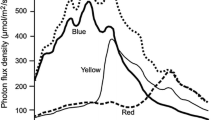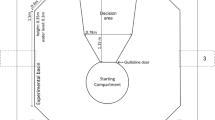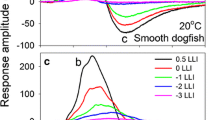Abstract
Spectral sensitivity functions were measured between 334 nm and 683 nm in Salamandra salamandra by utilizing two behavioral reactions: the negative phototactic response, and the prey catching behavior elicited by a moving worm dummy. The action spectrum of the negative phototactic response revealed 3 pronounced maxima: at 360–400 nm, at 520–540 nm, and at 600–640 nm. In the range around 450 nm, there was a “reaction gap” where sensitivity could not be measured. The action spectrum of the prey catching behavior was entirely different: maximal sensitivity was found at 500 nm and at 570 nm. Between 500 nm and 334 nm sensitivity decreased continuously for about 1 log unit (Fig. 6).
Experiments under chromatic adaptation using the prey catching behavior indicate that the relatively high sensitivity in the ultraviolet range is not due to a separate ultraviolet photoreceptor, but is based on the responses of a photoreceptor maximally sensitive at about 500 nm.
Color discrimination was tested by moving a colored worm dummy within a differently colored surround of equal subjective brightness. The salamanders were able to discriminate blue from green, and green from red (Fig. 10). The results can be explained by assuming a trichromatic color vision based on 3 photoreceptor types maximally sensitive around 450 nm, 500 nm and 570 nm (Fig. 12).
Similar content being viewed by others
References
Dietz M (1972) Erdkröten können UV-Licht sehen. Naturwissenschaften 59: 316
Donner KO, Reuter T (1976) Visual pigments and photoreceptor function. In: Llinás R, Precht W (eds) Frog neurobiology. Springer, Berlin Heidelberg New York, 251–277
Ewert J-P (1976) The visual system of the toad: behavioral and physiological studies on a pattern recognition system. In Fite KV (ed) The amphibian visual system. Academic Press, New York San Francisco London, 141–202
Govardovskii VI, Zueva LV (1974) Spectral sensitivity of the frog eye in the ultraviolet and visible region. Vision Res 14: 1317–1321
Grüsser-Cornehls U, Himstedt W (1976) The urodele visual system. In Fite KV (ed) The amphibian visual system. Academic Press, New York San Francisco London, 203–266
Hailman J, Jaeger R (1974) Phototactic responses to spectrally dominant stimuli and use of color vision by adult anuran amphibians: a comparative survey. Animal Behav 22: 757–795
Hárosi FI (1982) Recent results from single-cell microspectrophotometry: cone pigments from frog, fish and monkey. Color Res Applications 7: 135–141
Himstedt W (1971) Die Tagesperiodik von Salamandriden. Oecologia (Berl) 8: 194–208
Himstedt W (1972) Untersuchungen zum Farbensehen von Urodelen. J Comp Physiol 81: 229–238
Himstedt W (1982) Evolutionary aspects of color vision in amphibians. In: Mossakovski D, Roth G (eds) Environmental adaptation and evolution. Fischer, Stuttgart New York, 67–85
Himstedt W, Fischerleitner E (1975) Die Antworten von Retinaneuronen auf Farbreize bei Urodelen. Zool Jahrb Abt Allg Zool Physiol 79: 128–147
Himstedt W, Helas A, Sommer T (1981) Projection of color coding retinal neurons in urodele amphibians. Brain Behav Evol 18: 19–32
Honjo I (1939) Farbensinn der Feuersalamanderlarve. Mem Coll Sci Kyoto Imp Univ 15: Nr. 2
Ingle D (1973) Two visual systems in the frog. Science 111: 1053–1055
Jacobs G (1992) Ultraviolet vision in vertebrates. Am Zool 32: 544–554
Jaeger RG, Hailman JP (1973) Effects of intensity on the phototactic responses of adult anuran amphibians: a comparative survey. Z Tierpsychologie 33: 352–407
Kicliter E (1973) Flux, wavelength and movement discrimination in frogs: forebrain and midbrain contribution. Brain Behav Evol 8: 340–365
Kunz YW, Wildenburg G, Goodrich L, Callaghan E (1994) The fate of ultraviolet receptors in the retina of the atlantic salmon (Salmo salar). Vision Res 34: 1375–1383
Liebman PA, Entine G (1968) Visual pigments of frog and tadpole (Rana pipiens). Vision Res 8: 761–775
Makino CL, Taylor WR, Baylor DA (1991) Rapid charge movements and photosensitivity of visual pigments in salamander rods and cones. J Physiol 442: 761–780
Maximov V, Orlov O, Reuter T (1985) Chromatic properties of the retinal afferents in the thalamus and the tectum of the frog (Rana temporaria). Vision Res 25: 1037–1049
Meng M (1957) Untersuchungen zum Farben- und Formensehen der Erdkröte (Bufo bufo L.). Zool Beiträge 3/3: 313–363
Muntz WRA (1962a) Effectiveness of different colours of light in releasing the positive phototactic behaviour of frogs, and a possible function of the retinal projection to the diencephalon. J Neurophysiol 25: 712–720
Muntz WRA (1962b) Microelectrode recordings from the diencephalon of the frog (Rana pipiens) and a blue-sensitive system. J Neurophysiol 25: 712–720
Muntz WRA (1963) Phototaxis and green rods in urodeles. Nature 199: 620
Neumeyer C (1984) On spectral sensitvity in the goldfish: evidence for neural interactions between different cone mechanisms. Vision Res 24: 1223–1231
Neumeyer C (1992) Tetrachromatic color vision in goldfish: evidence from color mixture experiments. J Comp Physiol A 171: 639–649
Perry RJ, McNaughton PA (1991) Response properties of cones from the retina of the tiger salamander. J Physiol 433: 651–687
Reuter T (1969) Visual pigments and ganglion cell activity in the retinae of tadpoles and adult frogs (Rana temporaria L.). Acta Zoologica Fennica 122: 1–64
Reuter T, Virtanen K (1976) Color discrimination mechanisms in the retina of the toad (Bufo bufo L.). J Comp Physiol 109: 337–343
Roth G (1987) Visual behaviour in salamanders. Studies of brain function, Vol. 14, Springer Verlag, Heidelberg Berlin
Scheibner H, Hunold W, Bezaut M (1975) Color discrimination functions in the frog optic tectum (Rana esculenta). Vision Res 15: 1175–1180
Tempel P, Himstedt W (1979) Color vision in salamander larvae. Z Naturforsch 34: 890–891
Tempel P, Himstedt W, Steinke S (1982) Spectral sensitivity of visual neurons and of phototactic behaviour in Salamandra. Zool Jahrb Physiol 86: 401–412
Zipse W (1935) Können unsere heimischen Frösche und echten Kröten ultraviolettes Licht sehen? Zool Jahrb 55: 487–524
Author information
Authors and Affiliations
Rights and permissions
About this article
Cite this article
Przyrembel, C., Keller, B. & Neumeyer, C. Trichromatic color vision in the salamander (Salamandra salamandra). J Comp Physiol A 176, 575–586 (1995). https://doi.org/10.1007/BF00196422
Accepted:
Issue Date:
DOI: https://doi.org/10.1007/BF00196422




